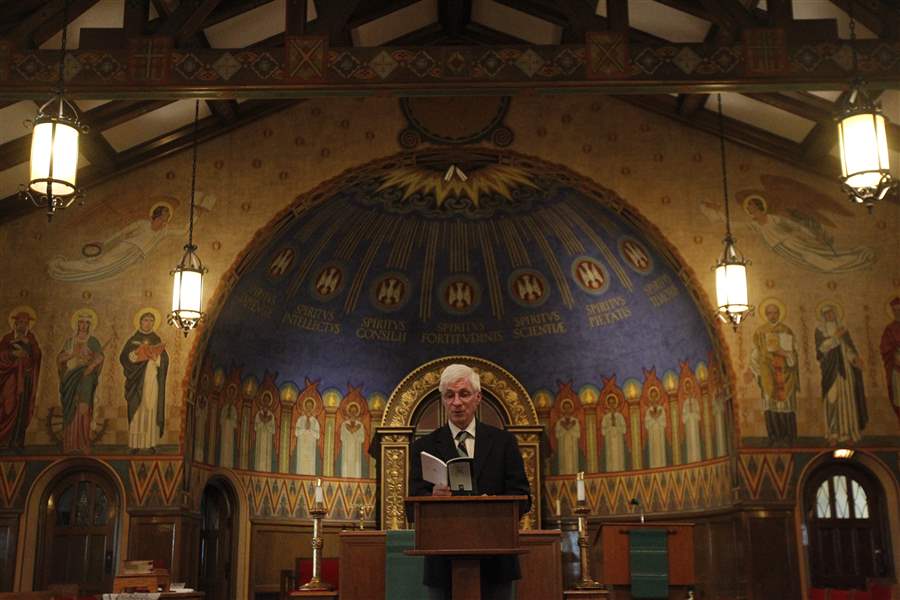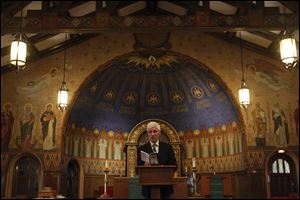
Recasting the net: Roman Catholic Church hopes to lure back believers through new evangelization
11/16/2013
Theologian Ralph Martin speaks with faculty, Catholic school principals, and even the bishop at the Central Catholic High Chapel.
The Blade/Amy E. Voigt
Buy This Image

Martin, left, greets Bishop Leonard Blair before speaking to the group.
The Diocese of Toledo, along with the global Roman Catholic Church, is giving attention to those who have left the sanctuary. It is trying to bring people back to its pews through what it calls new evangelization.
“Thirty percent of all Catholics are still going to Mass, and that's on a monthly basis,” said Greg Schlueter, the diocese's secretariat leader for evangelization and parish life. Almost 80 percent have left Catholicism by age 23, he said, citing published statistics. And “only 48 percent believe in a relationship with God.”
Bishop Leonard Blair, who is leaving Toledo to be archbishop of Hartford, Connecticut, said at a press conference Oct. 29 announcing his new position that Pope Francis and Church bishops are very aware of people's withdrawal from Catholicism, and the leaders are becoming more active in new evangelization to take “the message of the gospel lived in the community of the Church to people who may have been baptized Catholic but who are no longer practicing, or people who feel a kind of drift in their lives spiritually.”
Bishop Blair was at Central Catholic High School's Christ the King Chapel Oct. 24 when theologian Ralph Martin, the president of Renewal Ministries in Ann Arbor, Mich., and a professor who directs new evangelization education at Sacred Heart Major Seminary in Detroit, spoke to the high school's theology faculty and others about new evangelization.
Mr. Martin, author of the recently published book The Urgency of the New Evangelization: Answering the Call, said that the new evangelization comes from 50 years ago, from Vatican II reforms and direction in the Church. Before then, evangelization was for “the salvation of souls, [and] the very central motivation is people living in sin, living in darkness, living idolatry, cut off from the light of Christ, cut off from the truth of Christ, cut off from salvation,” he said. Converting people to Christianity was how people could be put on the path to salvation. Evangelization wasn't concerned with people already in the Church.
But a concept in the Church gained traction that “people can be saved already in ways without hearing the gospel,” Mr. Martin said. There wasn't a need to convert them to Catholicism. So missionaries dedicated themselves to human development, to helping others without also emphasizing soul salvation and attention to the story of Jesus. “A tailspin set in in missionary orders that hasn't really been resolved to this day.” Classic evangelization was becoming rare in Catholicism. And church members were leaving, too. Leaders looked for reinvigoration from their Christian gospel.
Popes Paul VI and John Paul II published documents that developed the new evangelization concept. Mr. Martin said that Pope Paul's “Evangelization in Our Day” is the document most quoted by Pope Francis. He quotes Pope Francis as saying, “We need to go to people and tell them about the mercy of God, tell them about the love of God.”

Theologian Ralph Martin speaks with faculty, Catholic school principals, and even the bishop at the Central Catholic High Chapel.
In his annual Murray/Bacik lecture delivered Wednesday night, Peter Feldmeier, who teaches Catholic studies at the University of Toledo, attributed these words to Pope Francis: “Perhaps the church appeared too distant from [people's] needs, too cold, too caught up with itself, a prisoner of its own rigid formulas, looking like a relic of the past; unfit for new questions. We need a church unafraid of going forth into their night; meeting them on their way; capable of entering into conversation; able to dialogue with those disciples who, having left Jerusalem behind, are wandering aimlessly, alone, with their own disappointment, disillusioned by a Christianity now considered a barren, fruitless soul, incapable of generating meaning…. Are we still a church capable of warming hearts?"
Now people at Catholic parishes are looking for ways to warm the hearts of former members, to get them to return to Mass and to take part in church life and activities. “The troubling thing,” Mr. Martin said, “is that people can come back to the Mass and not be converted. People can get active in the parish but not be interested in becoming a disciple of Christ.” So, Mr. Martin said, it is not just membership; the goal of Christian conversion must be clear.
And for those whose mission is to convert the Catholics to discipleship, “there isn't going to be a program for the new evangelization,” Mr. Martin said. Instead, “It's really a new way of looking at the situation we live in and adding a dimension over what we're already doing.… It's a new way of looking at sacramental preparation. It's a new way of looking at homilies and liturgy. It's a new way of looking at parish missions. It's a new way of looking at everything that we're doing, and the way we need to look at it is that many of the people we're in contact with, we can no longer assume understand what it means to be a committed Catholic and have made a personal commitment to that.”
Mr. Schlueter said that conversion today is not looked at as “'I've encountered [Jesus] and I'm ready to go for the rest of my life.' It's a daily thing; we face challenges and struggles.” To help people through those obstacles, “our challenge is to structure that adventure.”
Contact TK Barger @ tkbarger@theblade.com, 419-724-6278 or on Twitter @TK_Barger.